PONTIAC PONTIAC 1997 Owners Manual
Manufacturer: PONTIAC, Model Year: 1997, Model line: PONTIAC, Model: PONTIAC PONTIAC 1997Pages: 419, PDF Size: 19.67 MB
Page 241 of 419
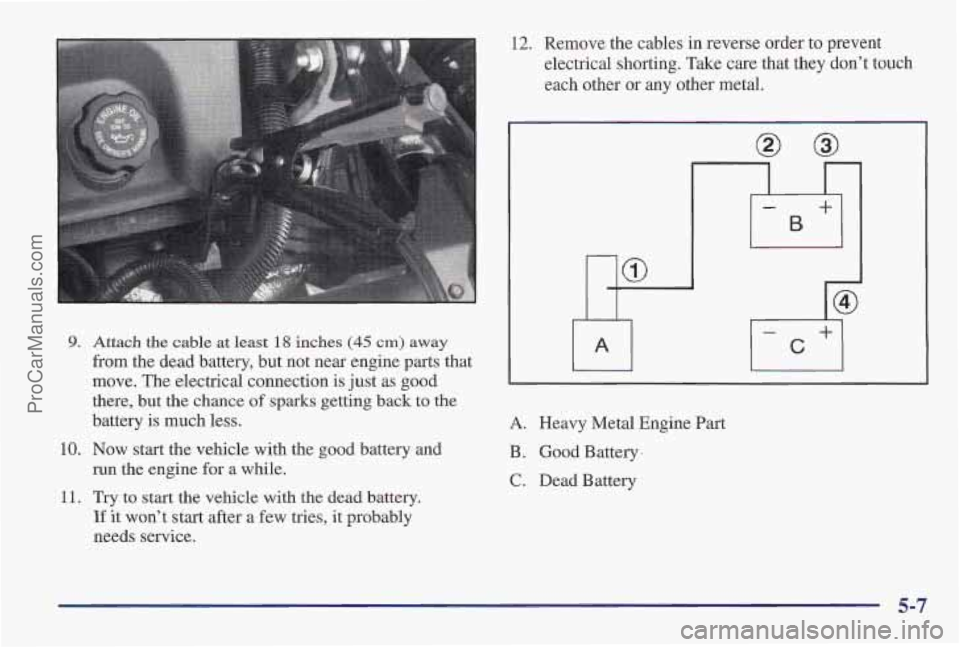
9.
10.
11.
Attach the cable at least 18 inches (45 cm) away
from the dead battery, but not near engine parts that
move. The electrical connection is just as good
there, but the chance
of sparks getting back to the
battery is much less.
Now start the vehicle with the good battery and
run the engine for a while.
Try to start the vehicle with the dead battery.
If it won’t start after a few tries, it probably
needs service.
12. Remove the cables in reverse order to prevent
electrical shorting. Take care that they don’t touch
each other or any other metal.
il
A. Heavy Metal Engine Part
B. Good Battery.
C. Dead Battery
5-7
ProCarManuals.com
Page 242 of 419
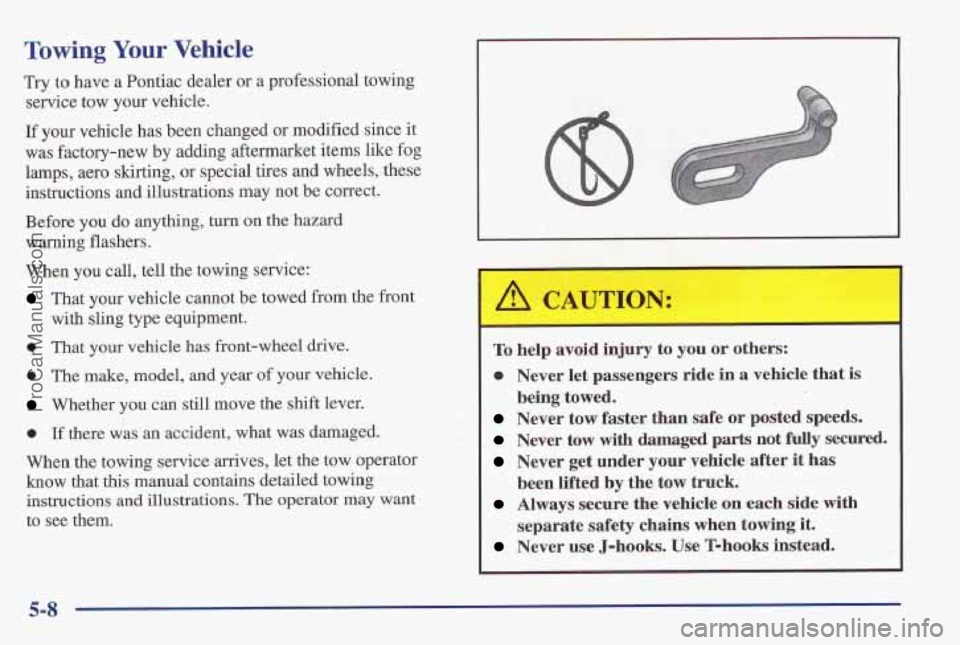
Towing Your Vehicle
Try to have a Pontiac dealer or a professional towing
service tow your vehicle.
If your vehicle has been changed or modified since it
was factory-new by adding aftermarket items like fog
lamps, aero skirting, or special tires and wheels, these
instructions and illustrations may not
be correct.
Before you
do anything, turn on the hazard
warning flashers.
When you call, tell the towing service:
That your vehicle cannot be towed from the front
with sling
type equipment.
0 That your vehicle has front-wheel drive.
0 The make, model, and year of your vehicle.
Whether you can still move the shift lever.
0 If there was an accident, what was damaged.
When the towing service arrives, let
the tow operator
know that this manual contains detailed towing
instructions and illustrations.
The operator may want
to see them.
r
I
To help avoid injury to you or others:
0 Never let passengers ride in a vehicle that is
Never tow faster than safe or posted speeds.
Never tow with damaged parts not fully secured.
Never get under your vehicle after it has
been lifted by the tow truck.
Always secure the vehicle on each side with
separate safety chains when towing it.
Never use J-hooks. Use T-hooks instead.
being towed.
5-8
ProCarManuals.com
Page 243 of 419
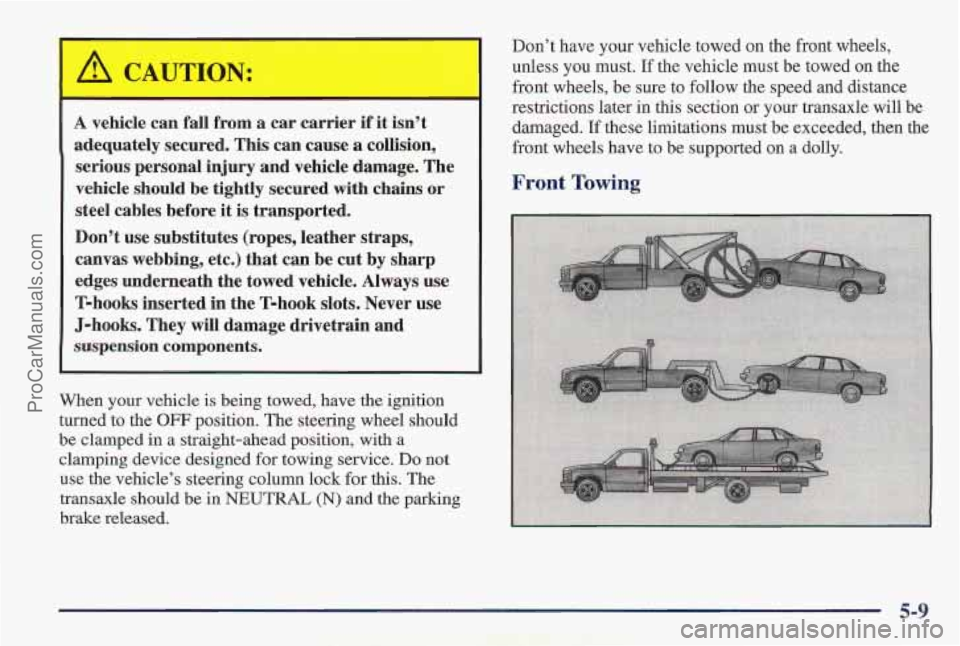
,-., ., . ........
A vehicle can fall from a car carrier if it isnst" .,''.' ''.
adequately secured. This can cause a collision,
serious personal injury and vehicle damage. The
vehicle should be tightly secured
with chains or
steel cables before
it is transported.
Don't use substitutes (ropes, leather straps,
canvas webbing, etc.) that can be cut by sharp
edges underneath the towed vehicle. Always use
T-hooks inserted in the T-hook slots. Never use
J-hooks. They will damage drivetrain and
suspension components.
When your vehicle is being towed, have the ignition
turned to the
OFF position. The steering wheel should
be clamped in
a straight-ahead position, with a
clamping device designed for towing service.
Do not
use the vehicle's steering column lock for this. The
transaxle should be in
NEUTRAL (N) and the parking
brake released. Don't have your vehicle towed on the front
wheels,
unless you must.
If the vehicle must be towed on the
front wheels,
be sure to follow the speed and distance
restrictions later in this section or your transaxle will be
damaged.
If these limitations must be exceeded, then the
front wheels have to be supported
on a dolly.
Front Towing
ProCarManuals.com
Page 244 of 419
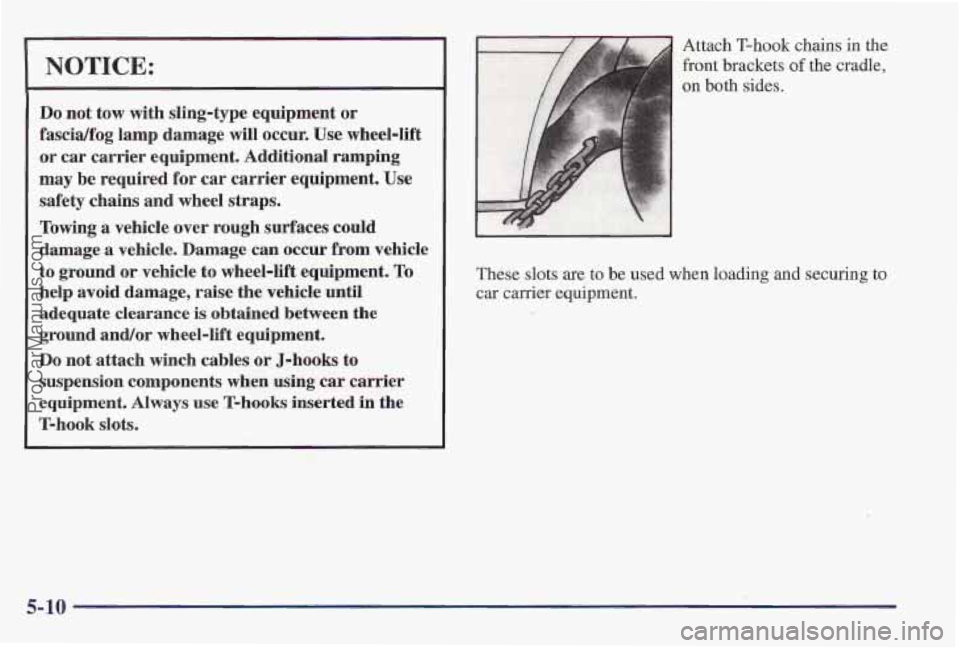
NOTICE:
Do not tow with sling-type equipment or
fascidfog lamp damage will occur. Use wheel-lift
or car carrier equipment, Additional ramping
may
be required for car carrier equipment. Use
safety chains and wheel straps.
Towing a vehicle over rough surfaces could
damage
a vehicle. Damage can occur €.om vehicle
to ground or vehicle
to wheel-lift equipment. To
help avoid damage, raise the vehicle until
adequate clearance
is obtained between the
ground and/or wheel-lift equipment.
Do not attach winch cables or Jnhooks to
suspension components when using car carrier
equipment. Always use T-hooks inserted in the
T-hook slots.
Attach T-hook chains in the
front brackets
of the cradle,
ow both sides.
These slots are to be used when loading and securing to
car carrier equipment.
5-10
ProCarManuals.com
Page 245 of 419
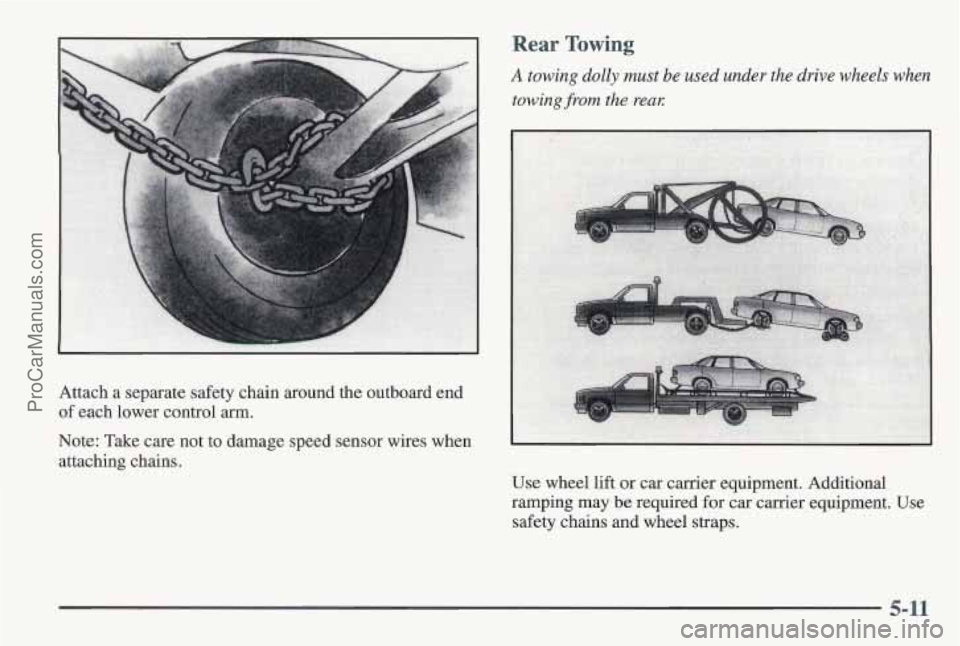
Attach a separate safety chain around the outboard end
of each lower control arm.
Rear Towing
A towing dolly must be used under the drive wheels when
towing from the real:
Note: Take care not to damage speed sensor wires when
attaching chains.
Use wheel lift or car carrier equipment. Additional
ramping may
be required for car carrier equipment. Use
safety chains and wheel straps.
5-11
ProCarManuals.com
Page 246 of 419
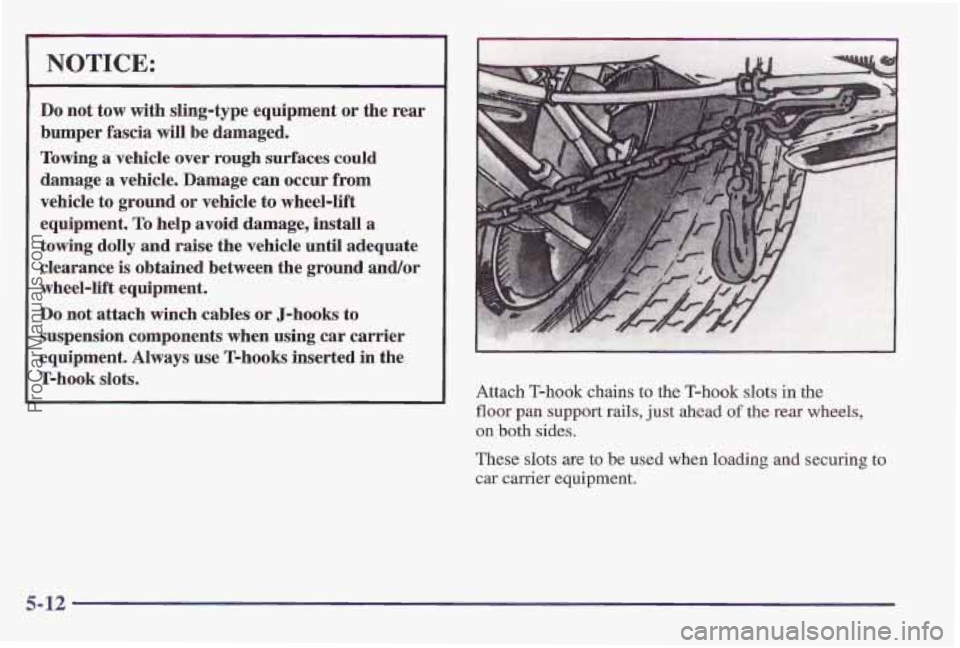
NOTICE:
Do not tow with sling-type equipment or the rear
bumper fascia will be damaged.
Towing a vehicle over rough surfaces could
damage
a vehicle. Damage can occur from
vehicle to ground or vehicle to wheel-lift
equipment,
To help avoid damage, install a
towing dolly and raise the vehicle until adequate
clearance
is obtained between the ground and/or
wheel-lift equipment.
Do not attach winch cables or J-hooks to
suspension components when using car carrier
equipment. Always
use '6-books inserted in the
T-hook slots.
Attach T-hook chains to the T-hook slots in the
floor pan support rails, just ahead of the rear wheels,
on both sides.
These slots are to be used when loading and securing to
car carrier equipment.
5-12
ProCarManuals.com
Page 247 of 419
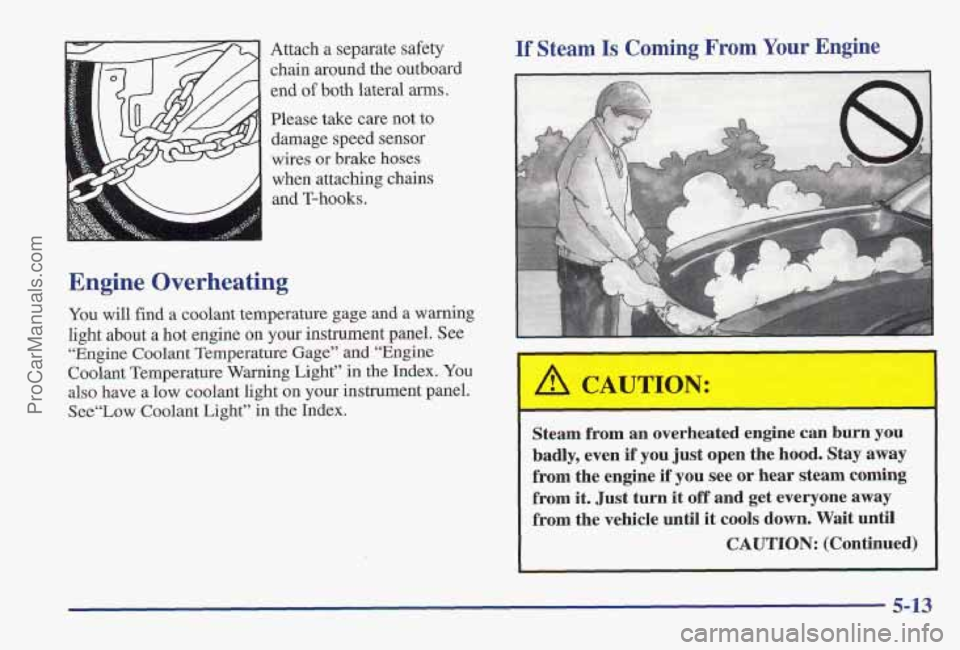
Attach a separate safety
chain around the outboard
end
of both lateral arms.
Please take care not to
damage speed sensor
wires or brake
hoses
when attaching chains
l.1 and T-hooks. -
Engine Overheating
You will find a coolant temperature gage and a warning
light about
a hot engine on your instrument panel. See
“Engine Coolant Temperature Gage” and “Engine
Coolant Temperature Warning Light” in the Index.
You
also have a low coolant light on your instrument panel.
Sed‘Low Coolant Light” in the Index.
If Steam Is Coming From Your Engine
Steam from an overheated engine can burn you
badly, even if you just open the hood. Stay away
from the engine if you see or hear steam coming
from it. Just turn it off and get everyone away
from the vehicle until it cools down. Wait until
CAUTION: (Continued)
5-13
ProCarManuals.com
Page 248 of 419
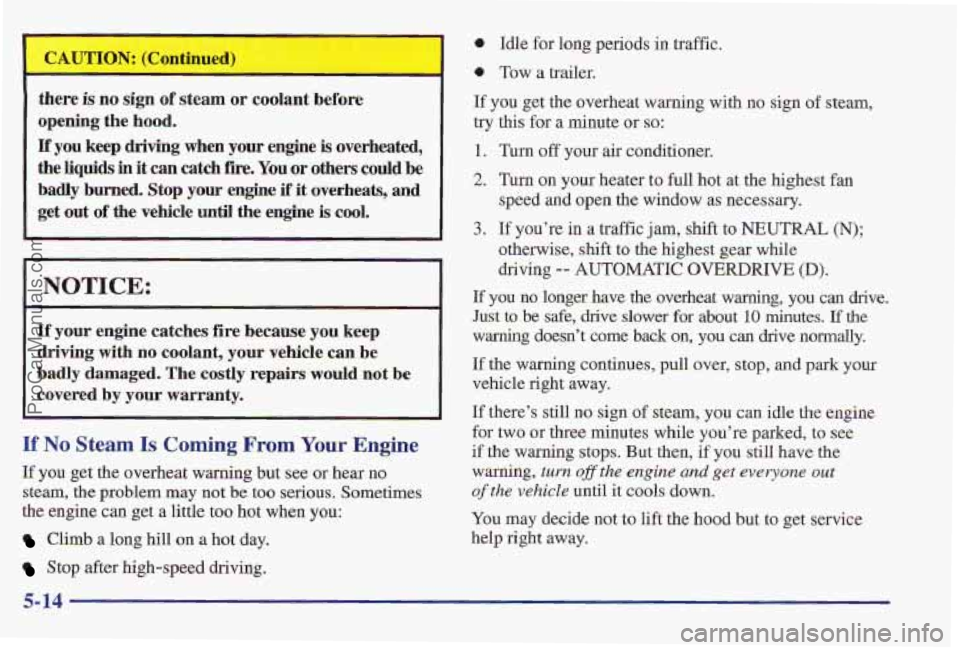
tnere is no sign of steam or coolant before
opening the hood.
If you keep driving when your engine is overheated,
the
liquids in it can catch fire. You or others could be
badly burned. Stop your engine if it overheats, and
get out
of the vehicle until the engine is cool.
I NOTICE:
If your engine catches fire because you keep
driving
with no coolant, your vehicle can be
badly damaged. The costly repairs would not
be
covered by your warranty.
If No Steam Is Coming From Your Engine
If you get the overheat warning but see or hear no
steam, the problem may not be too serious. Sometimes
the engine can get a little
too hot when you:
Climb a long hill on a hot day.
Stop after high-speed driving. Idle for long
periods in traffic.
* Tow a trailer.
If you get the overheat warning with no sign of steam,
try this for a minute or so:
1. Turn off your air conditioner.
2. Turn on your heater to full hot at the highest fan
speed and open the window as necessary.
3. If you’re in a traffic jam, shift to NEUTRAL (N);
otherwise, shift to the highest gear while
driving
e- AUTOMATIC OVERDRIVE (D).
If you no longer have the overheat warning, you can dnve.
Just to be safe, drive slower for about 10 minutes. If the
warning doesn’t come back on, you can drive normally.
If the warning continues, pull over, stop, and park your
vehicle right away.
If there’s still no sign of steam, you can idle the engine
for two or three minutes while you’re parked, to see
if the warning stops. But then, if you still have the
warning, turn off the engine and get everyone out
of the vehicle until it cools down.
You may decide not to lift the hood but to get service
help right away.
5-14
ProCarManuals.com
Page 249 of 419
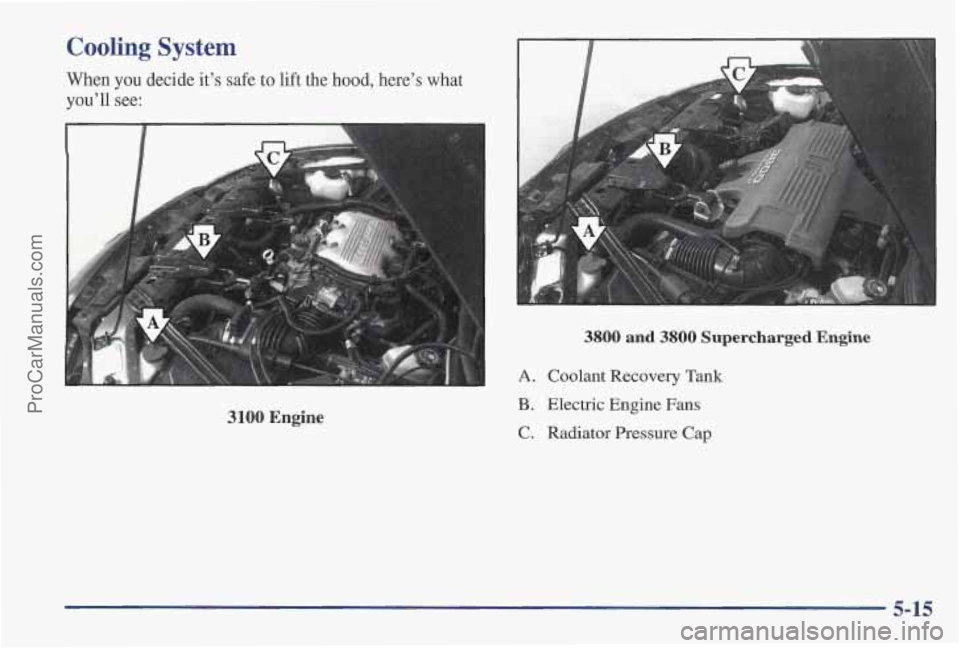
Cooling System
When you decide it’s safe to lift the hood, here’s what
you’ll see:
3100 Engine
3800 and 3800 Supercharged Engine
A. Coolant Recovery Tank
B. Electric Engine Fans
C. Radiator Pressure Cap
5-15
ProCarManuals.com
Page 250 of 419
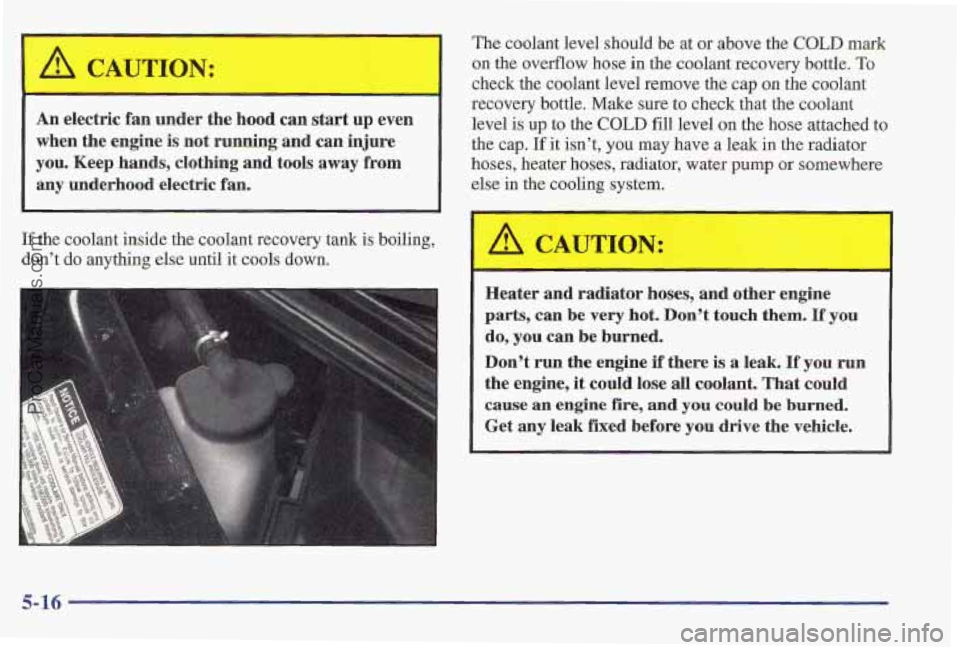
I
An electric fan under the hood can start up even
when the engine is not running and can injure
you. Keep hands, clothing
and tools away from
any underhood electric fan.
If the coolant inside the coolant recovery tank is boiling,
don’t
do anything else until it cools down.
The coolant level should be at or above the COLD mark
on the overflow hose in the coolant recovery bottle. To
check the coolant level remove the cap on the coolant
recovery bottle. Make sure to check that the coolant
level is up to the
COLD fill level on the hose attached to
the cap.
If it isn’t, you may have a leak in the radiator
hoses, heater hoses, radiator, water
pump or somewhere
else in the cooling system.
Heater and radiator hoses, a i other engine
parts, can
be very hot. Don’t touch them. If you
do, you can be burned.
Don’t run the engine if there is a leak. If you run
the engine,
it could lose all coolant. That could
cause
an engine fire, and you could be burned.
Get any leak fixed before you drive the vehicle.
5-16
ProCarManuals.com